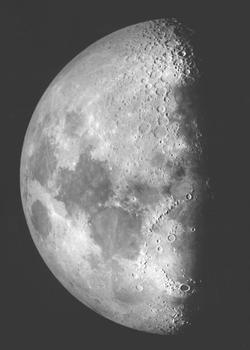Most Formed With Planets, Not As Result Of Collision
 The next time you take a moonlit
stroll... or admire a full, bright-white moon looming in the night
sky... you might count yourself lucky, say astronomers at NASA's
Jet Propulsion Laboratory.
The next time you take a moonlit
stroll... or admire a full, bright-white moon looming in the night
sky... you might count yourself lucky, say astronomers at NASA's
Jet Propulsion Laboratory.
New observations from NASA's Spitzer Space Telescope (shown
below) suggest moons like Earth's -- formed out of tremendous
collisions -- are uncommon in the universe, arising at most in only
five to 10 percent of planetary systems.
"When a moon forms from a violent collision, dust should be
blasted everywhere," said Nadya Gorlova of the University of
Florida, Gainesville, lead author of a new study that appeared last
week in the Astrophysical Journal. "If there were lots of moons
forming, we would have seen dust around lots of stars -- but we
didn't."
Scientists believe Earth's moon arose about 30 to 50 million
years after our sun was born, and after our rocky planets had begun
to take shape. A body as big as Mars is thought to have smacked
into an infant Earth, breaking off a piece of its mantle. Some of
the resulting debris fell into orbit around Earth, eventually
coalescing into the moon we see today. The other moons in our solar
system either formed simultaneously with their planet, or were
captured by their planet's gravity.
Gorlova and her colleagues looked for the dusty signs of similar
smash-ups around 400 stars that are all about 30 million years old
-- roughly the age of our sun when Earth's moon formed. They found
that only one out of the 400 stars is immersed in the telltale
dust. Taking into consideration the amount of time the dust should
stick around, and the age range at which moon-forming collisions
can occur, the scientists then calculated the probability of a
solar system making a moon like Earth's to be at most five to 10
percent.
"We don't know that the collision we witnessed around the one
star is definitely going to produce a moon, so moon-forming events
could be much less frequent than our calculation suggests," said
George Rieke of the University of Arizona, Tucson, a co-author of
the study.
In addition, the observations tell astronomers that the
planet-building process itself winds down by 30 million years after
a star is born. Like our moon, rocky planets are built up through
messy collisions that spray dust all around. Current thinking holds
that this process lasts from about 10 to 50 million years after a
star forms. The fact that Gorlova and her team found only 1 star
out of 400 with collision-generated dust indicates that the
30-million-year-old stars in the study have, for the most part,
finished making their planets.
"Astronomers have observed young stars with dust swirling around
them for more than 20 years now," said Gorlova. "But those stars
are usually so young that their dust could be left over from the
planet-formation process. The star we have found is older, at the
same age our sun was when it had finished making planets and the
Earth-moon system had just formed in a collision."

For moon lovers, the news isn't all bad. For one thing, moons
can form in different ways. And, even though the majority of rocky
planets in the universe might not have moons like Earth's,
astronomers believe there are billions of rocky planets out there.
Five to 10 percent of billions is still a lot of moons.
Other authors of the paper include: Zoltan Balog, James
Muzerolle, Kate Y. L. Su and Erick T. Young of the University of
Arizona, and Valentin D. Ivanov of the European Southern
Observatory, Chile.
 Airborne-Flight Training 05.09.24: ERAU at AIAA, LIFT Diamond Buy, Epic A&P
Airborne-Flight Training 05.09.24: ERAU at AIAA, LIFT Diamond Buy, Epic A&P ANN's Daily Aero-Term (05.07.24): Hazardous Weather Information
ANN's Daily Aero-Term (05.07.24): Hazardous Weather Information Aero-News: Quote of the Day (05.07.24)
Aero-News: Quote of the Day (05.07.24) NTSB Final Report: Cessna 150
NTSB Final Report: Cessna 150 Aero-News: Quote of the Day (05.08.24)
Aero-News: Quote of the Day (05.08.24)




